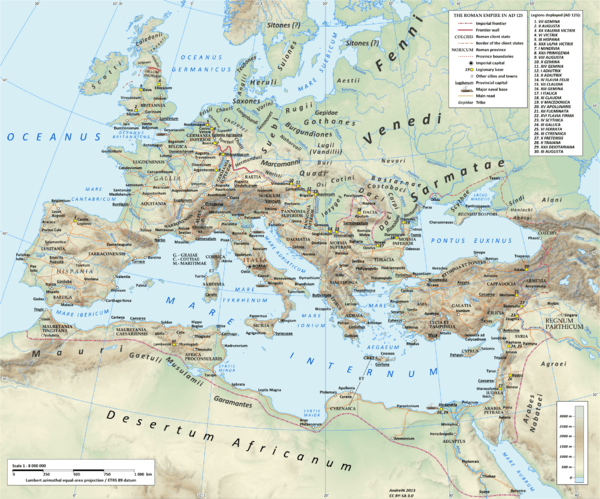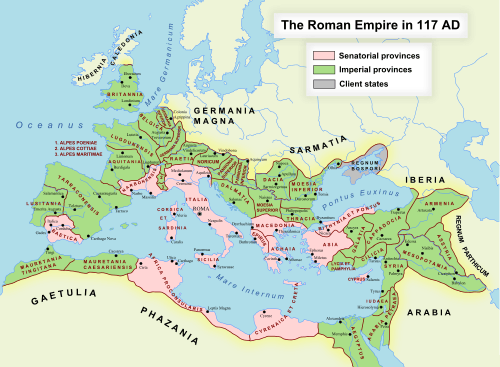Syria (Roman province)
| Provincia Syria Συριακή επαρχία | |||||
| Province of the Roman Empire | |||||
| |||||
 | |||||
| Capital | Antioch | ||||
| History | |||||
| - | Conquest of Syria-Coele by Pompey | 64 BC | |||
| - | Incorporation of Syria Palaestina | 135 AD | |||
| Today part of | | ||||
Part of a series on the |
|---|
| History of Syria |
 |
| Prehistory |
| Bronze Age |
| Antiquity |
|
| Middle Ages |
|
| Early modern |
| Modern |
|
| Timeline |
| Syria portal |
Syria was an early Roman province, annexed to the Roman Republic in 64 BC by Pompey in the Third Mithridatic War following the defeat of Armenian King Tigranes the Great.[1] Following the partition of the Herodian Kingdom into tetrarchies in 6 AD, it was gradually absorbed into Roman provinces, with Roman Syria annexing Iturea and Trachonitis. Later, in 135 AD, in the aftermath of the Bar Kokhba revolt, Syrian province was merged with Judea province, creating the larger province of Syria Palaestina.
Principate

The Syrian army accounted for three legions of the Roman army, defending the Parthian border. In the 1st century AD, it was the Syrian army that enabled Vespasian's coup.
Syrian province forces were directly engaged in the Great Jewish Revolt of 66–70 AD. In 66 AD, Cestius Gallus, the legate of Syria, brought the Syrian army, based on XII Fulminata, reinforced by auxiliary troops, to restore order in Judaea and quell the revolt. The legion, however, was ambushed and destroyed by Jewish rebels at the Battle of Beth Horon, a result that shocked the Roman leadership.
The Syrian legion later took part also in the crackdown upon Judaea during the Bar-Kokhba War of 132–136.
In 244 AD, Rome was ruled by a native Syrian from Shahba by the name of Marcus Julius Philippus, more commonly known as Philip the Arab. Philip became the 33rd emperor of Rome upon its millennial celebration.
Aftermath
Syria Palaestina
In the final accords of the Bar-Kokhba Revolt, the province of Syria was expanded to include greatly depopulated Judaea, becoming Syria Palaestina. From the later 2nd century, the Roman senate included several notable Syrians, including Claudius Pompeianus and Avidius Cassius.
Shortly after 193, during the reign of Syrian Severan dynasty, Syria Palaestina was split into Syria Coele in the north and Phoenice in the south. Syria was of crucial strategic importance during the crisis of the third century. From 260 to 273, Syria was part of the breakaway Palmyrene Empire.
Dominate
Following the reforms of Diocletian, Syria Coele became part of the Diocese of Oriens.[2] Sometime between 330 and 350 (likely c. 341), the province of Euphratensis was created out of the territory of Syria Coele along the western bank of the Euphrates and the former realm of Commagene, with Hierapolis as its capital.[3]
Syria in the Byzantine Empire
After c. 415 Syria Coele was further subdivided into Syria I (or Syria Prima), with the capital remaining at Antioch, and Syria II (Syria Secunda) or Syria Salutaris, with capital at Apamea on the Orontes. In 528, Justinian I carved out the small coastal province Theodorias out of territory from both provinces.[2]
The region remained one of the most important provinces of the Byzantine Empire. It was occupied by the Sassanids between 609 and 628, then recovered by the emperor Heraclius, but irreversibly lost again to the advancing Muslims after the battle of Yarmouk and the fall of Antioch.[2]
Episcopal sees
Ancient episcopal sees of the late Roman province of Syria I listed in the Annuario Pontificio as titular sees:[4]
- Anasartha
- Barcusus (Baquza)
- Beroea
- Chalcis in Syria
- Gabala
- Gabula (at the marsh of Djebbul, Djabbul?)
- Gindarus
- Laodicea in Syria
- Salamias
- Seleucia Pieria
Ancient episcopal sees of the late Roman province of Syria II listed in the Annuario Pontificio as titular sees:[4]
- Apamea in Syria
- Arethusa
- Balanea
- Epiphania in Syria
- Larissa in Syria
- Mariamme
- Raphanea
- Seleucobelus
See also
- History of Syria
- Ottoman Syria
- Assyria (Roman province)
- List of governors of Roman Syria
References
- ↑ Between Rome and Jerusalem: 300 years of Roman-Judaean relations By Martin Sicker. Books.google.co.uk. Retrieved 26 July 2012.
- ↑ 2.0 2.1 2.2 Kazhdan, Alexander (Ed.) (1991). Oxford Dictionary of Byzantium. Oxford University Press. p. 1999. ISBN 978-0-19-504652-6.
- ↑ Kazhdan, Alexander (Ed.) (1991). Oxford Dictionary of Byzantium. Oxford University Press. p. 748. ISBN 978-0-19-504652-6.
- ↑ 4.0 4.1 Annuario Pontificio 2013 (Libreria Editrice Vaticana 2013 ISBN 978-88-209-9070-1), "Sedi titolari", pp. 819-1013
External links
- Bagnall, R., J. Drinkwater, A. Esmonde-Cleary, W. Harris, R. Knapp, S. Mitchell, S. Parker, C. Wells, J. Wilkes, R. Talbert, M. E. Downs, M. Joann McDaniel, B. Z. Lund, T. Elliott, S. Gillies. "Places: 981550 (Syria)". Pleiades. Retrieved March 8, 2012.
| ||||||||||||||||||||||||||||||||||||||||||||||||||||||||||||||||||||||||||||||||||||||||||||||||||||||||||||||||||||||||||||||||||||||||||||||||||||||||||||||||||||||||||||||||||
| ||||||
| ||||||||
